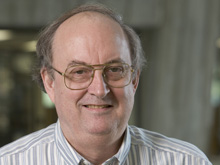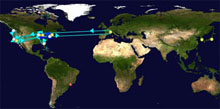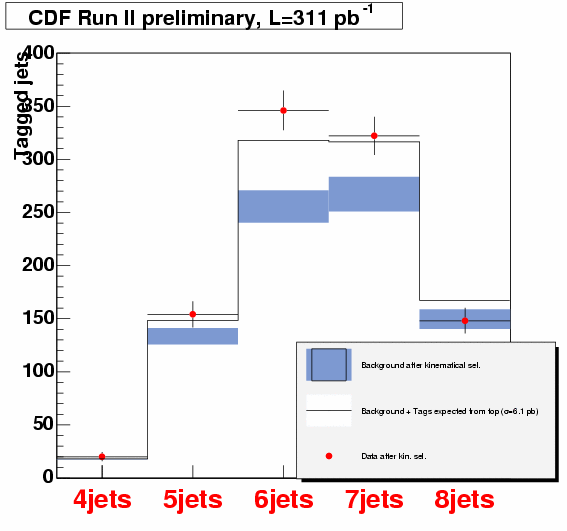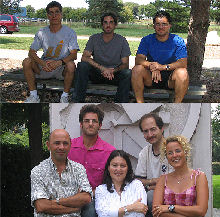 | Thursday, September 22, 2005 |
|
Thursday, September 22 10:00 a.m.-5:00 p.m. ILC Industrial Forum - 1 West 2:30 p.m. Theoretical Physics Seminar - Curia II Speaker: H. Fritzsch, Ludwig-Maximilians-Universitšt, Munich Title: Constituent Quarks and the Spin of the Nucleon 3:30 p.m. Director's Coffee Break - 2nd Flr X-Over Note: There will be no Accelerator Physics and Technology Seminar today
Friday, September 23 |
|
Extended Forecast |
Secon Level 3 |
|
Thursday, September 22 - Minnesota Wild Rice w/Chicken - Tuna Melt on Nine Grain - BBQ Ribs - Chicken Casserole - Buffalo Chicken Wrap - Mexican Pizza - Chicken Pecan Salad The Wilson Hall Cafe accepts Visa, Master Card, Discover and American Express at Cash Register #1. |
|
Thursday, September 22 Dinner - Coquille St. Jacques - White Bean & Fennel Puree - Julienne of Summer Squashes - Almond Baklava
Wednesday, September 28
Chez Leon Menu |
| Fermilab Today is online at: http://www.fnal.gov/today/ Send comments and suggestions to today@fnal.gov Fermilab Today archive Hurricane Relief Page Fermilab Today PDF Version Fermilab Result of the Week archive Fermilab Safety Tip of the Week archive Linear Collider News archive Fermilab Today classifieds Subscribe/Unsubscribe to |
| When I'm Sixty Four: Symposium
for Bill Bardeen
|
 |
|
|
| Bill Bardeen has been a theoretical physicist at Fermilab for over 20 years. |
|
On Friday and Saturday, September 23-24, Fermilab will host a symposium to honor Bill Bardeen for a lifetime of achievement in theoretical physics. With talks by many of the leading theorists who helped to shape our current understanding of particle physics, the symposium will be a thought-provoking celebration for this newly-turned 64-year-old.
Bardeen is best known for his work on anomalies in quantum field theory, which play a fundamental role in shaping the structure of the Standard Model and the subtle interactions of mesons. He has advanced our understanding of the origin of mass and was an early founder of QCD, our theory of the strong force, which holds quarks together in the proton and neutron, and is mediated by gluons. After holding research positions at SUNY-Stonybrook and Princeton University, and teaching physics at Stanford University, Bardeen came to Fermilab in 1975 on the invitation of Ben Lee. He served as head of the Theoretical Physics department from 1985 to 1992, spent a year at the SSC, and then returned to Fermilab's Theory Group when the project was canceled. Bardeen was awarded the J.J. Sakurai Prize of the American Physical Society in 1996 for his work on anomalies and perturbative quantum Chromodynamics, the theory of the strong force. In 1984, he became a Fellow of the American Physical Society and in 1999 he was elected a Member of the National Academy of Sciences.
The Bardeen Symposium will run in One West all day on Friday and Saturday, and the talks are open to the Fermilab community. On Friday, a 3:40 p.m. session with Bardeen's brother, cosmologist Jim Bardeen, and particle theorist Andrzej Buras, will replace the usual Joint Experimental Theoretical Physics Seminar.
|
Lighting Up Advanced Networks
"Current networks are a black box, you put bits of data in with a destination in mind, and hope they come out quickly on the other end," said physicist Shawn McKee from the University of Michigan. "The network makes no guarantees, and there's no way to negotiate with it. We're looking into how to make the network a managed component of grids, like computing and storage resources are now."
|
|
From Rapid City,S.D. Journal, September 20, 2005: State, mine officials sign Homestake pact LEAD, S.D.- South Dakota Governor Mike Rounds pledged Tuesday to begin a statewide campaign to win support for his plan to spend $35.6 million to convert the closed Homestake gold mine in Lead into an underground science laboratory. "Today is the first step in the sales pitch to the rest of South Dakota to confirm how special this opportunity is," Rounds told a crowd of more than 100 people gathered at Gold Run Park in Lead. The state Legislature already has committed $15.7 million to the Homestake lab proposal, including a $10 million federal grant engineered by Sen. Tim Johnson, D-S.D., three years ago. Now, Rounds will ask for another $19.9 million, probably in a special legislative session sometime in October. The governor called the underground lab proposal "a once-in-a-lifetime opportunity for our young people to benefit from a national laboratory within our borders."
|
| Six Jets To The Top |
|
The measurement of the top-antitop (ttbar) quark production rate is an
important test of the strong force predictions in the Standard Model. Here we
present the measurement of the ttbar production cross section in the "all
hadronic" decay mode, where the W bosons from the top and antitop decay
hadronically into quarks, appearing in the detector as collimated streams of
particles called jets.
The event signature is quite spectacular since it has six high energy jets, two originating from b quarks. This is the most frequent decay mode of ttbar pairs, but unfortunately this signature is mimicked by ordinary background sources which are several orders of magnitude bigger. To find all-hadronic ttbar, a large data set of four million events with multiple jets are collected. In order to exploit the distinctive properties of the ttbar decay, events are chosen with six highly energetic jets that poplulate the detector in a uniform way. Finally, two b quarks are required. Since the b quarks have a long lifetime their decay vertex will be displaced from the collision point. The high resolution of the CDF silicon vertex detector distinguishes b jets from jets from lighter quarks. The CDF analysis successfully isolates the ttbar signal in this difficult channel and measures a cross-section of 7.5 +3.7 -2.8 pb. The team is currently finalizing a top mass measurement from the same events.
|
| Result of the Week Archive |
|
September 19-21 - During this forty-eight hour period operations established one store that combined with an existing store provided the experiments with approximately 32 hours and 36 minutes of luminosity - NuMI off due to dripping water -Preaccelerator switched to the I- Source -TeV quench
Read the Current Accelerator Update
|
|
Open Enrollment for the Medical and Dental Insurance Plans Ends Friday The open enrollment form must be in by 5:00 p.m. on September 23, 2005. You can access further information on the Web Bill Bardeen Symposium Discount Show Tickets World Year of Physics Symposium for Students and Teachers
Theater for a Good Cause
|


